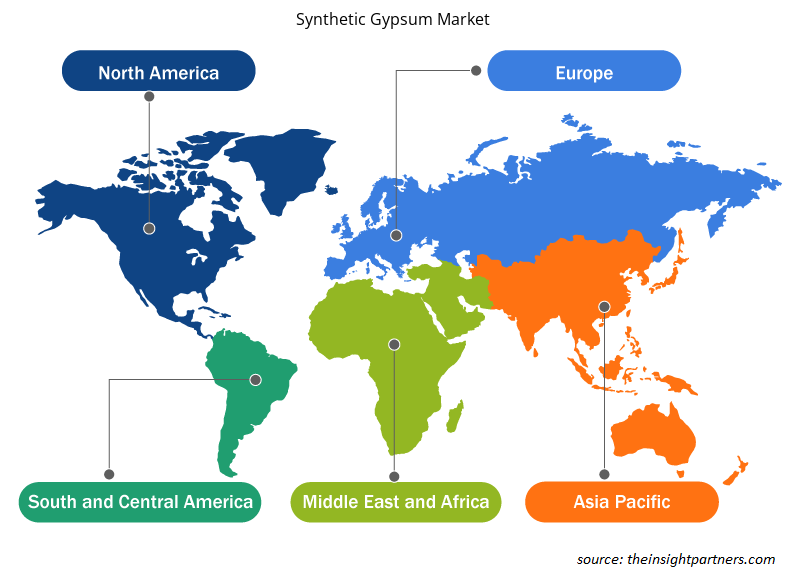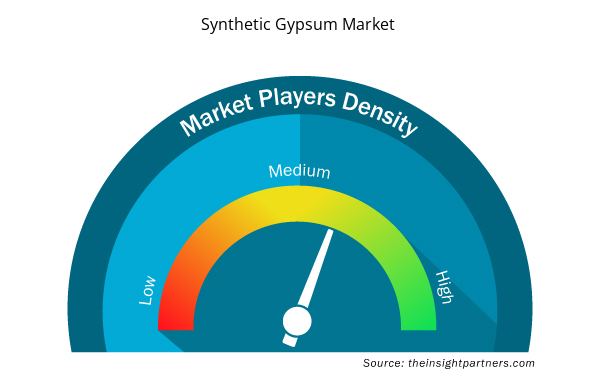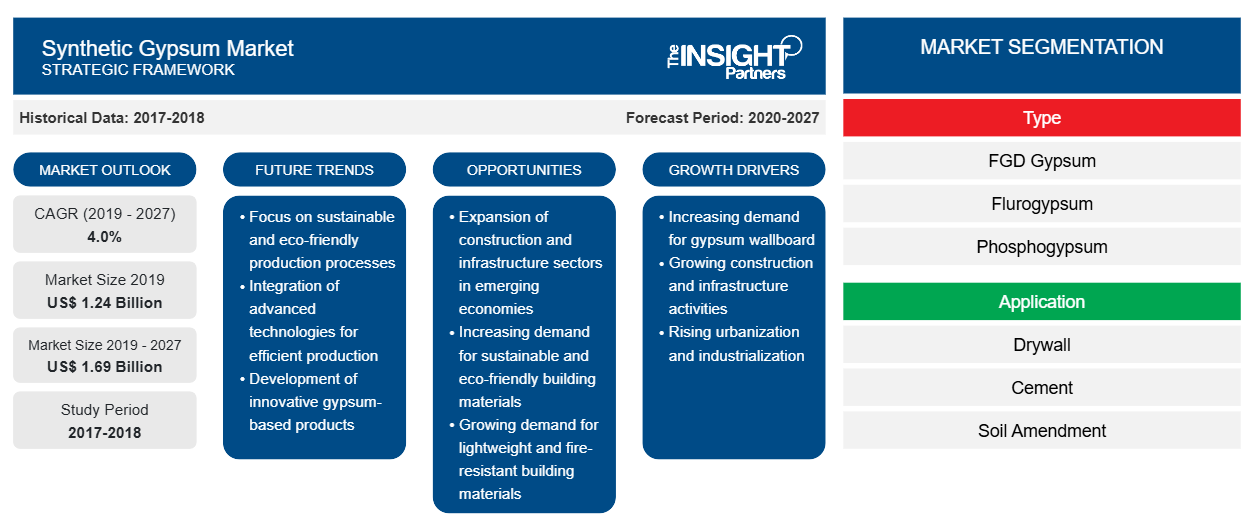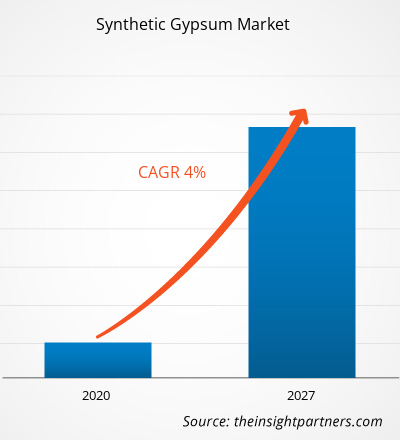[Forschungsbericht] Der globale Markt für synthetischen Gips wurde im Jahr 2019 auf 1.244,02 Millionen US-Dollar geschätzt und soll bis 2027 1.693,72 Millionen US-Dollar erreichen; von 2020 bis 2027 wird ein durchschnittliches jährliches Wachstum von 4,0 % erwartet.
Synthetischer Gips wird hauptsächlich in der Bau- und Landwirtschaftsindustrie verwendet. Das Wachstum der Bauindustrie weltweit hat die Nachfrage nach dekorativen Strukturen und Trockenbauwänden erhöht, was wiederum die Nachfrage nach synthetischem Gips ankurbelt. Darüber hinaus fördert die Verwendung von synthetischem Gips als Füllstoff im Zementherstellungsprozess das Wachstum des Marktes für synthetischen Gips.
Im Jahr 2019 hatte Nordamerika den größten Anteil am globalen Markt für synthetischen Gips. Das Wachstum des nordamerikanischen Marktes ist auf die wachsende Bauindustrie in den USA und die Entstehung verschiedener FGD-Systemunternehmen in Nordamerika zurückzuführen. Aufgrund der zunehmenden Urbanisierung und Industrialisierung nehmen die Bauaktivitäten in der Region zu. Dies stimuliert die Nachfrage nach Stadterneuerungsprojekten, was wiederum die Nachfrage nach synthetischem Gips ankurbelt, der zur Herstellung von Zement, Trockenbau und dekorativen Strukturen verwendet wird.
Der COVID-19-Ausbruch wirkt sich aufgrund von Lockdowns, Reiseverboten und Betriebsschließungen negativ auf die Wirtschaft und Industrie in verschiedenen Ländern aus. Die globale Chemie- und Materialindustrie ist eine der wichtigsten Branchen, die unter ernsthaften Störungen wie Lieferkettenunterbrechungen, Absagen von Technologieveranstaltungen und Büroschließungen leidet. China beispielsweise ist das globale Produktionszentrum und der größte Rohstofflieferant für verschiedene Branchen und gleichzeitig eines der am schlimmsten betroffenen Länder. Die Schließung verschiedener Werke und Fabriken in China schränkt die globalen Lieferketten ein und stört die Produktionsaktivitäten, Lieferpläne und den Verkauf verschiedener Chemikalien und Materialien. Verschiedene Unternehmen haben bereits mögliche Verzögerungen bei Produktlieferungen und einen Einbruch der zukünftigen Verkäufe ihrer Produkte angekündigt. Darüber hinaus behindern die von Ländern in Europa, Asien und Nordamerika verhängten globalen Reiseverbote die Möglichkeiten für Geschäftskooperationen und Partnerschaften. All diese Faktoren behindern die Chemie- und Materialindustrie und wirken somit als hemmende Faktoren für das Wachstum verschiedener Märkte, die mit dieser Branche verbunden sind.
Passen Sie diesen Bericht Ihren Anforderungen an
Sie erhalten kostenlos individuelle Anpassungen an jedem Bericht, einschließlich Teilen dieses Berichts oder einer Analyse auf Länderebene, eines Excel-Datenpakets sowie tolle Angebote und Rabatte für Start-ups und Universitäten.
- Holen Sie sich die wichtigsten Markttrends aus diesem Bericht.Dieses KOSTENLOSE Beispiel umfasst eine Datenanalyse von Markttrends bis hin zu Schätzungen und Prognosen.
Markteinblicke
Steigende Nachfrage aus der Bauindustrie
Die Nachfrage nach synthetischem Gips ist in der Bauindustrie gestiegen. In der Bauindustrie wird synthetischer Gips hauptsächlich als Füllstoff für Zement und Putz verwendet, um deren Festigkeit zu erhöhen und die Abbindezeit des Betons zu verkürzen. Er wird auch zur Herstellung von dekorativen Platten und Gips verwendet. REA-Gips, eine Art synthetischen Gipses, wird in der Bauindustrie hauptsächlich zur Herstellung von Zement, Trockenbauwänden und Gips verwendet. REA-Gips ist grundsätzlich recycelbar und wird daher von den Herstellern hauptsächlich verwendet. Gips wird hauptsächlich zur Herstellung von dekorativen Platten, Strukturen und Skulpturen verwendet. Die Nachfrage nach diesen Strukturen und Skulpturen steigt in der Bauindustrie, was zu einer steigenden Nachfrage nach synthetischem Gips führt. Die Regierungen vieler Entwicklungsländer konzentrieren sich auf die Entwicklung und Verbesserung ihrer Infrastruktur und führen viele Reformen und Vorschriften ein, die dazu beitragen werden, die Immobilien- und Infrastrukturbranche anzukurbeln. All diese Vorschriften und Reformen dürften sich positiv auf die Bauwirtschaft auswirken und im Prognosezeitraum zu einer Steigerung der Nachfrage nach synthetischem Gips führen.paris. FGD gypsum, which is one of the types of synthetic gypsum, is mainly used in the construction industry to manufacture cement, drywall, and plaster of paris. FGD gypsum is basically recyclable in nature and thus, is mostly used by the manufacturers. Plaster of Paris is basically used for making decorative panels, structures, and sculptures. The demand for these structures and sculptures are increasing in the construction industry, which is leading to an increase in the demand of synthetic gypsum. The governments of many developing countries are focusing on developing and improving their infrastructure and are introducing many reforms and regulations that will help in boosting the real-estate and infrastructure industries. All these regulations and reforms are expected to have a positive impact on the construction industry, which would boost the demand for synthetic gypsum in the forecast period.
Typ-Einblicke
Der Markt für synthetischen Gips ist nach Typ in REA-Gips, Flurgips, Phosphogips, Citrogips und andere unterteilt. Das Segment REA-Gips war 2019 mit dem größten Anteil Marktführer.FGD gypsum, Flurogypsum, Phosphogypsum, Citrogypsum, and Others. The FGD gypsum segment led the market with the largest share in 2019. REA-Gips ist im Wesentlichen der Gips, der aus Rauchgasentschwefelungsanlagen gewonnen wird. Der Schwefel wird größtenteils aus dem Rauchgas entfernt, was mithilfe von Kalk in der Rauchgasentschwefelungsanlage erfolgen kann. REA-Gips hat größtenteils die gleiche chemische Identität wie natürlicher Gips und gilt als Gips mit höherer Reinheit. Die Verwendung von REA-Gips gilt als ökologisch vorteilhaft. REA-Gips wird in der Landwirtschaft verwendet und kann unter Boden- und hydrogeologischen Bedingungen zum Zweck der Bodenerhaltung und des industriellen Materialrecyclings verwendet werden. Der Prozess, durch den REA-Gips hergestellt wird, ist umweltfreundlich und bietet eine ökologische Quelle für reinen Gips. REA-Gips wird in verschiedenen Prozessen wie Zementherstellung, Wasseraufbereitung, Glasherstellung, Bergbauanwendungen, Gipsplattenprodukten, Straßenbau und Landwirtschaft verwendet. Er kann auch als Nährstoffquelle für Nutzpflanzen verwendet werden. gypsum is basically the gypsum obtained from the flue gas desulfurization systems. The sulfur is mostly removed from the flue gas, which can be done through the help of lime in the flue gas desulfurization system. The FGD gypsum mostly has the same chemical identity as that of a natural gypsum, and it is considered as a gypsum of greater purity. The use of FGD gypsum is considered as ecologically beneficial. FGD gypsum has agricultural applications and can be used in soil and hydrogeologic conditions for the purpose of soil conservation and industrial material recycling. The process through which FGD gypsum is manufactured is eco-friendly and provides an ecological source of pure gypsum. FGD gypsum has various applications in processes such as cement production, water treatment, glass making, mining applications, gypsum panel products, highway construction, and agriculture. It can also be used as a source of nutrition for crops.
Einige wichtige Marktteilnehmer auf dem Markt für synthetischen Gips sind Drax Group PLC, American Gypsum, USG Corporation, Larargeholcim, Travancore Titanium Products Limited, Knauf Gips KG, Transparent Technologies Limited, BauMineral GMBH, Steag GMBH und Boral. Wichtige Marktteilnehmer konzentrieren sich auf Strategien wie Fusionen und Übernahmen sowie Produkteinführungen, um ihre geografische Präsenz und Kundenbasis weltweit zu erweitern. Drax Group PLC, American Gypsum, USG Corporation, Larargeholcim, Travancore Titanium Products Limited, Knauf Gips KG, Transparent Tehcnologies Limited, BauMineral GMBH, Steag GMBH, and Boral. Major players in the market are focusing on strategies such as mergers and acquisitions, and product launches to expand their geographical presence and consumer base globally.
Regionale Einblicke in den Markt für synthetischen Gips
Die regionalen Trends und Faktoren, die den Markt für synthetischen Gips im Prognosezeitraum beeinflussen, wurden von den Analysten von Insight Partners ausführlich erläutert. In diesem Abschnitt werden auch die Marktsegmente und die Geografie für synthetischen Gips in Nordamerika, Europa, im asiatisch-pazifischen Raum, im Nahen Osten und Afrika sowie in Süd- und Mittelamerika erörtert.

- Erhalten Sie regionale Daten zum Markt für synthetischen Gips
Umfang des Marktberichts über synthetischen Gips
| Berichtsattribut | Details |
|---|---|
| Marktgröße im Jahr 2019 | 1,24 Milliarden US-Dollar |
| Marktgröße bis 2027 | 1,69 Milliarden US-Dollar |
| Globale CAGR (2019 - 2027) | 4,0 % |
| Historische Daten | 2017-2018 |
| Prognosezeitraum | 2020–2027 |
| Abgedeckte Segmente | Nach Typ
|
| Abgedeckte Regionen und Länder | Nordamerika
|
| Marktführer und wichtige Unternehmensprofile |
|
Dichte der Marktteilnehmer für synthetischen Gips: Die Auswirkungen auf die Geschäftsdynamik verstehen
Der Markt für synthetischen Gips wächst rasant, angetrieben durch die steigende Nachfrage der Endverbraucher aufgrund von Faktoren wie sich entwickelnden Verbraucherpräferenzen, technologischen Fortschritten und einem größeren Bewusstsein für die Vorteile des Produkts. Mit steigender Nachfrage erweitern Unternehmen ihr Angebot, entwickeln Innovationen, um die Bedürfnisse der Verbraucher zu erfüllen, und nutzen neue Trends, was das Marktwachstum weiter ankurbelt.
Die Marktteilnehmerdichte bezieht sich auf die Verteilung der Firmen oder Unternehmen, die in einem bestimmten Markt oder einer bestimmten Branche tätig sind. Sie gibt an, wie viele Wettbewerber (Marktteilnehmer) in einem bestimmten Marktraum im Verhältnis zu seiner Größe oder seinem gesamten Marktwert präsent sind.
Die wichtigsten auf dem Markt für synthetischen Gips tätigen Unternehmen sind:
- Drax Group PLC
- Amerikanischer Gips
- USG Corporation
- Larargeholcim
- Travancore Titanium Products Limited
Haftungsausschluss : Die oben aufgeführten Unternehmen sind nicht in einer bestimmten Reihenfolge aufgeführt.

- Überblick über die wichtigsten Akteure auf dem Markt für synthetischen Gips
Bericht-Spotlights
- Fortschrittliche Branchentrends auf dem globalen Markt für synthetischen Gips helfen den Akteuren bei der Entwicklung wirksamer langfristiger Strategien
- In Industrie- und Entwicklungsländern angewandte Strategien für Unternehmenswachstum
- Quantitative Analyse des globalen Marktes für synthetischen Gips von 2017 bis 2027
- Schätzung der Nachfrage nach synthetischem Gips in verschiedenen Branchen
- PEST-Analyse zur Veranschaulichung der Wirksamkeit der in der Branche tätigen Käufer und Lieferanten bei der Vorhersage des Marktwachstums
- Aktuelle Entwicklungen zum Verständnis des Wettbewerbsmarktszenarios und der Nachfrage nach synthetischem Gips
- Markttrends und -aussichten in Verbindung mit Faktoren, die das Wachstum des synthetischen Gipsmarktes vorantreiben und bremsen
- Entscheidungsprozess durch das Verständnis von Strategien, die das kommerzielle Interesse im Hinblick auf das globale Wachstum des synthetischen Gipsmarktes untermauern
- Marktgröße für synthetischen Gips an verschiedenen Marktknoten
- Detaillierte Übersicht und Segmentierung des globalen Marktes für synthetischen Gips sowie seiner Dynamik in der Branche
- Marktgröße für synthetischen Gips in verschiedenen Regionen mit vielversprechenden Wachstumschancen
Markt für synthetischen Gips nach Typ
- REA-Gips
- Flurgips
- Phosphogips
- Zitronengips
- Sonstiges
Synthetischer Gipsmarkt, nach Anwendung
- Trockenbau
- Zement
- Bodenverbesserung
- Zahnmedizin
- Wasseraufbereitung
- Sonstiges
Firmenprofile
- Drax Group PLC
- Amerikanischer Gips
- USG Corporation
- Larargeholcim
- Travancore Titanium Products Limited
- Knauf Gips KG
- Transparent Technologies Limited
- BauMineral GMBH
- Steag GMBH
- Boral
- Historische Analyse (2 Jahre), Basisjahr, Prognose (7 Jahre) mit CAGR
- PEST- und SWOT-Analyse
- Marktgröße Wert/Volumen – Global, Regional, Land
- Branche und Wettbewerbsumfeld
- Excel-Datensatz



Report Coverage
Revenue forecast, Company Analysis, Industry landscape, Growth factors, and Trends

Segment Covered
This text is related
to segments covered.

Regional Scope
North America, Europe, Asia Pacific, Middle East & Africa, South & Central America

Country Scope
This text is related
to country scope.
Häufig gestellte Fragen
Phosphogypsum is basically referred to those gypsum which are formed are mostly formed when phosphate ore is processed into fertilizer which is done through the usage of sulfuric acid. Phosphogypsum is a reusable and a safe resource which has various applications. The gypsum contains low concentration of radium which is obtained from the source rock, which must be characterized carefully because on the basis of the levels the regulators may need to specify certain restrictions. Phosphogypsum can be used in various applications in the segments like agriculture, building materials, roads construction and more. It is a multi-nutrient Sulphur rich-fertilizer which can be used as soil amendment in order to displace the high levels of sodium and magnesium salts.
The major players operating in the global avocado oil market are Drax Group PLC, American Gypsum, USG Corporation, Larargeholcim, Travancore Titanium Products Limited, Knauf Gips KG, Transparent Tehcnologies Limited, BauMineral GMBH, Steag GMBH, and Boral.
In 2019, North America contributed to the largest share in the global synthetic gypsum market. The growth of the synthetic gypsum market in North America is attributed to the construction industry in the U.S. as well as emergence of various FGD system companies in the North American region. Due to the rising urbanization and industrialization, the construction activities in the region are escalating. This is stimulating the demand for urban renewal projects which will increase the demand for synthetic gypsum that will be used in making cement, drywall and decorative structures which will drive the growth of synthetic gypsum market in North America.
Trends and growth analysis reports related to Chemicals and Materials : READ MORE..
The List of Companies - Synthetic Gypsum Market
- Drax Group PLC
- American Gypsum
- USG Corporation
- Larargeholcim
- Travancore Titanium Products Limited
- Knauf Gips KG
- Transparent Tehcnologies Limited
- BauMineral GMBH
- Steag GMBH
- Boral
The Insight Partners performs research in 4 major stages: Data Collection & Secondary Research, Primary Research, Data Analysis and Data Triangulation & Final Review.
- Data Collection and Secondary Research:
As a market research and consulting firm operating from a decade, we have published and advised several client across the globe. First step for any study will start with an assessment of currently available data and insights from existing reports. Further, historical and current market information is collected from Investor Presentations, Annual Reports, SEC Filings, etc., and other information related to company’s performance and market positioning are gathered from Paid Databases (Factiva, Hoovers, and Reuters) and various other publications available in public domain.
Several associations trade associates, technical forums, institutes, societies and organization are accessed to gain technical as well as market related insights through their publications such as research papers, blogs and press releases related to the studies are referred to get cues about the market. Further, white papers, journals, magazines, and other news articles published in last 3 years are scrutinized and analyzed to understand the current market trends.
- Primary Research:
The primarily interview analysis comprise of data obtained from industry participants interview and answers to survey questions gathered by in-house primary team.
For primary research, interviews are conducted with industry experts/CEOs/Marketing Managers/VPs/Subject Matter Experts from both demand and supply side to get a 360-degree view of the market. The primary team conducts several interviews based on the complexity of the markets to understand the various market trends and dynamics which makes research more credible and precise.
A typical research interview fulfils the following functions:
- Provides first-hand information on the market size, market trends, growth trends, competitive landscape, and outlook
- Validates and strengthens in-house secondary research findings
- Develops the analysis team’s expertise and market understanding
Primary research involves email interactions and telephone interviews for each market, category, segment, and sub-segment across geographies. The participants who typically take part in such a process include, but are not limited to:
- Industry participants: VPs, business development managers, market intelligence managers and national sales managers
- Outside experts: Valuation experts, research analysts and key opinion leaders specializing in the electronics and semiconductor industry.
Below is the breakup of our primary respondents by company, designation, and region:

Once we receive the confirmation from primary research sources or primary respondents, we finalize the base year market estimation and forecast the data as per the macroeconomic and microeconomic factors assessed during data collection.
- Data Analysis:
Once data is validated through both secondary as well as primary respondents, we finalize the market estimations by hypothesis formulation and factor analysis at regional and country level.
- Macro-Economic Factor Analysis:
We analyse macroeconomic indicators such the gross domestic product (GDP), increase in the demand for goods and services across industries, technological advancement, regional economic growth, governmental policies, the influence of COVID-19, PEST analysis, and other aspects. This analysis aids in setting benchmarks for various nations/regions and approximating market splits. Additionally, the general trend of the aforementioned components aid in determining the market's development possibilities.
- Country Level Data:
Various factors that are especially aligned to the country are taken into account to determine the market size for a certain area and country, including the presence of vendors, such as headquarters and offices, the country's GDP, demand patterns, and industry growth. To comprehend the market dynamics for the nation, a number of growth variables, inhibitors, application areas, and current market trends are researched. The aforementioned elements aid in determining the country's overall market's growth potential.
- Company Profile:
The “Table of Contents” is formulated by listing and analyzing more than 25 - 30 companies operating in the market ecosystem across geographies. However, we profile only 10 companies as a standard practice in our syndicate reports. These 10 companies comprise leading, emerging, and regional players. Nonetheless, our analysis is not restricted to the 10 listed companies, we also analyze other companies present in the market to develop a holistic view and understand the prevailing trends. The “Company Profiles” section in the report covers key facts, business description, products & services, financial information, SWOT analysis, and key developments. The financial information presented is extracted from the annual reports and official documents of the publicly listed companies. Upon collecting the information for the sections of respective companies, we verify them via various primary sources and then compile the data in respective company profiles. The company level information helps us in deriving the base number as well as in forecasting the market size.
- Developing Base Number:
Aggregation of sales statistics (2020-2022) and macro-economic factor, and other secondary and primary research insights are utilized to arrive at base number and related market shares for 2022. The data gaps are identified in this step and relevant market data is analyzed, collected from paid primary interviews or databases. On finalizing the base year market size, forecasts are developed on the basis of macro-economic, industry and market growth factors and company level analysis.
- Data Triangulation and Final Review:
The market findings and base year market size calculations are validated from supply as well as demand side. Demand side validations are based on macro-economic factor analysis and benchmarks for respective regions and countries. In case of supply side validations, revenues of major companies are estimated (in case not available) based on industry benchmark, approximate number of employees, product portfolio, and primary interviews revenues are gathered. Further revenue from target product/service segment is assessed to avoid overshooting of market statistics. In case of heavy deviations between supply and demand side values, all thes steps are repeated to achieve synchronization.
We follow an iterative model, wherein we share our research findings with Subject Matter Experts (SME’s) and Key Opinion Leaders (KOLs) until consensus view of the market is not formulated – this model negates any drastic deviation in the opinions of experts. Only validated and universally acceptable research findings are quoted in our reports.
We have important check points that we use to validate our research findings – which we call – data triangulation, where we validate the information, we generate from secondary sources with primary interviews and then we re-validate with our internal data bases and Subject matter experts. This comprehensive model enables us to deliver high quality, reliable data in shortest possible time.


 Holen Sie sich ein kostenloses Muster für diesen Bericht
Holen Sie sich ein kostenloses Muster für diesen Bericht